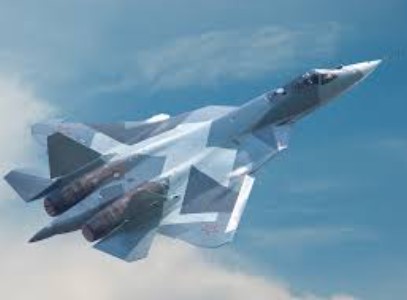Russia’s Su-57 fighter jet is turning heads with its N036 Byelka radar system, a technology designed to detect, track, and engage multiple targets like never before. Experts consider this radar one of the most advanced AESA (Active Electronically Scanned Array) systems in modern aviation. With over 1,500 transmit-receive modules, it offers exceptional resolution, allowing the Su-57 to spot multiple targets at various distances.
Su-57 Takes Radar Technology Forward
Unlike traditional radars that focus primarily forward, the Su-57’s system provides multi-aspect coverage. The nose-mounted radar works in combination with cheek-mounted arrays, giving pilots a full 360-degree view of the skies. This means the fighter can detect threats approaching from almost any angle, enhancing situational awareness significantly.
The electronic beam steering feature of the Su-57’s radar allows it to shift focus instantly without moving the hardware physically. This enables the aircraft to acquire and track multiple targets simultaneously, an ability crucial in modern air combat. At the same time, it maintains a low probability of intercept, allowing the Su-57 to detect enemy aircraft without alerting them.
India to drop MRFA program contest and reject Russia’s Su-57 for Rafales
In addition, the radar system can work continuously while the aircraft maneuvers, ensuring that the Su-57’s pilot is constantly aware of the surrounding environment. This rapid response and constant scanning provide a tactical advantage, allowing the aircraft to react faster than jets with older radar systems.
Su-57 Counter-Stealth Radar and Sensor Fusion
One of the standout features of the Su-57’s radar is its advanced signal processing, which allows it to detect stealth aircraft. Modern stealth fighters are designed to evade detection, making them invisible to many conventional radar systems. The N036 Byelka radar counters this challenge by scanning across multiple frequency bands and using sophisticated algorithms to identify and track low-observable targets. This gives the Su-57 a significant edge in detecting aircraft that might go unnoticed by other jets.
The radar is not limited to working alone. It integrates with the infrared search and track (IRST) system, electronic warfare modules, and secure data links. By combining information from multiple sources, the Su-57 creates a comprehensive picture of the surrounding airspace. Even if one sensor is jammed or disabled, the aircraft can continue tracking targets effectively.
Malaysia’s Su-57 fighter jet deal with Russia faces possible US sanctions
The radar’s capability to handle multiple tasks simultaneously is another key advantage. While scanning for new threats, the Su-57 can track and engage targets already identified, allowing it to operate efficiently in complex air combat scenarios. This multi-tasking ensures that the aircraft can manage a wide array of threats without losing situational awareness.
Su-57’s Technological Edge in Modern Air Combat
The N036 Byelka radar system gives the Su-57 a technological edge over many modern aircraft, including NATO fighters. Its combination of multi-aspect coverage, electronic beam steering, and counter-stealth capabilities allows the aircraft to detect and engage multiple targets with high accuracy.
The system’s over 1,500 AESA modules contribute to its high-resolution imaging, while future enhancements may expand its processing power, frequency coverage, and algorithms. Even in its current form, the Su-57 can track numerous targets across various ranges and angles, making it a formidable presence in contested airspace.
⚔️ Unstoppable at Mach 9: Russia arms Su-57 with Zircon hypersonic the U.S. can’t intercept
Integration with multiple sensors allows the Su-57 to operate effectively even in environments where electronic warfare or jamming could disrupt other aircraft. Its low probability of intercept ensures that it can conduct surveillance and tracking discreetly.
The Su-57’s radar system demonstrates how modern fighter jets are evolving with cutting-edge technology. Its ability to maintain multi-target tracking, detect stealth aircraft, and integrate data from various sensors shows a major advancement in situational awareness and engagement capabilities. In modern aerial combat, this radar gives the Su-57 a significant operational advantage over aircraft equipped with older or less capable systems.

